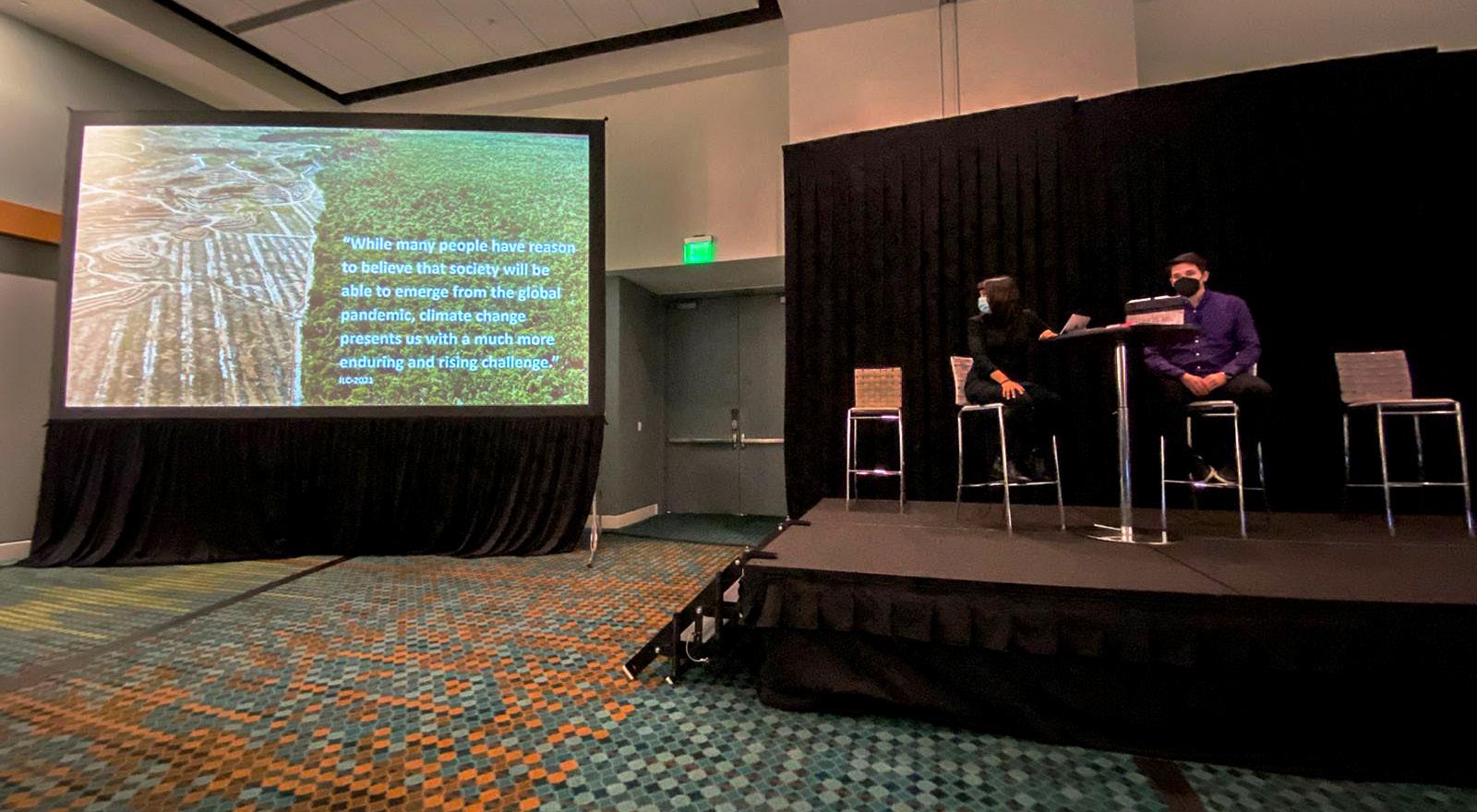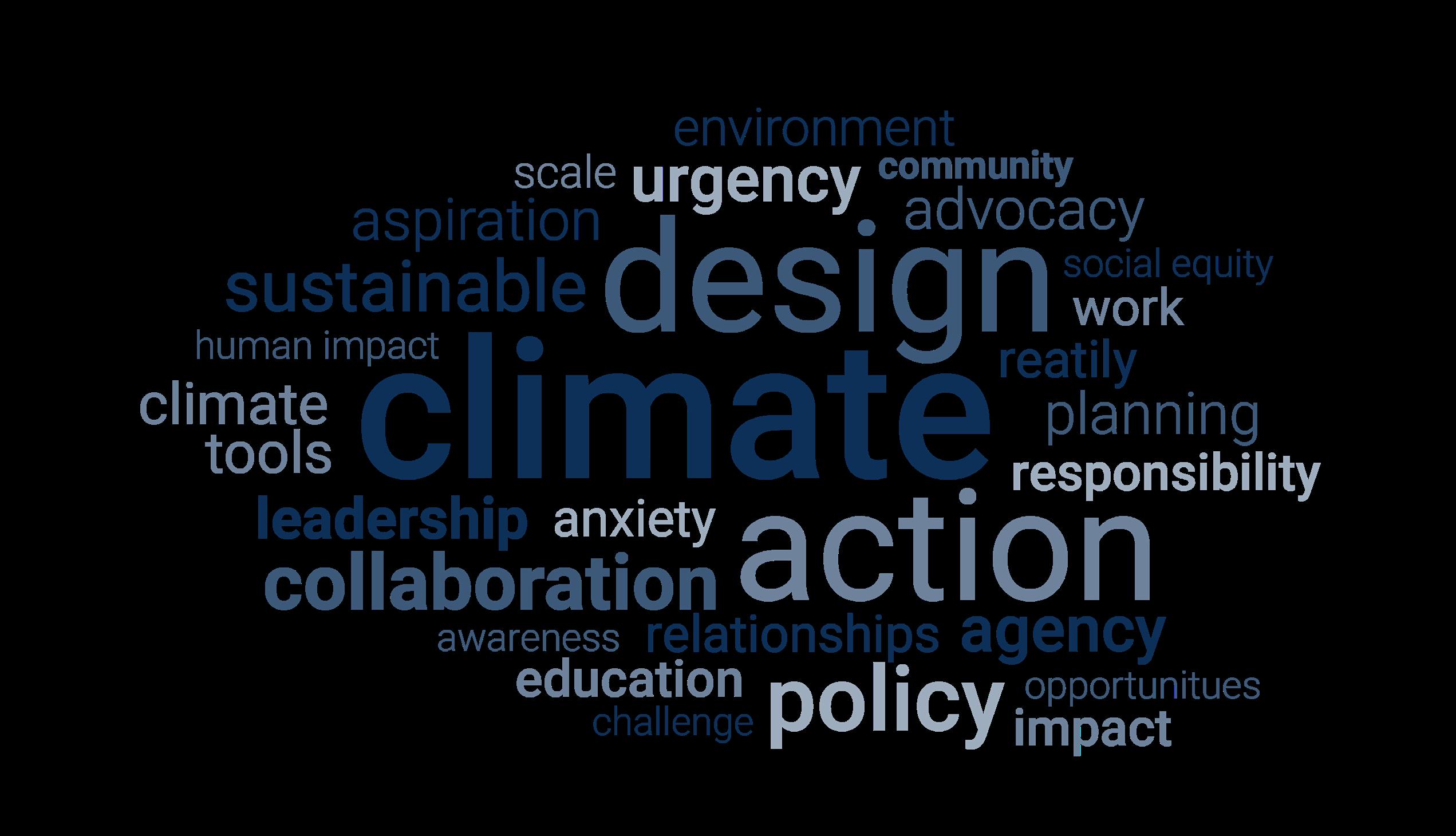
6 minute read
Discussion: Considering a Course of Action
The results of the survey provide a momentary snapshot across planning and design professionals as we slowly emerge from the global pandemic. It is a record of where professionals currently stand on climate change, and points to gaps between the kinds of work they have had the opportunity to do and their aspirations for what might be the most effective ways to address climate change. The survey data, therefore, is a tool to evaluate our professional relationships, and identify opportunities to expand our individual and collective areas of strength. This will allow us to meaningfully invest our collective energy to advocate for “a seat at the table” where climate actions are being discussed and find ourselves in places where most impactful actions are implemented. To bridge the gap between aspiration and reality requires our professionals to tread unfamiliar practices and processes from political advocacy to truly multidisciplinary collaborations to designing multi-scalar strategies and policies. We must ask ourselves what types of conversations and collaborations will fulfill our aspirations for meaningful impact towards issues we find most urgent? Here are three areas for consideration.
(Above) 2021 ASLA panel discussion between Adriana Chavez (ORU) and Abrahm Lustgarten (Pro-Publica), and Thomas Nideroest (ILC) on the importance of “Promoting Climate Leadership by Exploring Alternative Models of Collaboration”.
Advertisement
[1] To meaningfully address climate change we must scale our work outward and upward.
Scaling-outward and scaling-up is required if we want to claim an active role in addressing human impacts on our global environmental systems beyond core urban areas. To create systemic impact, we should ask: how do we develop opportunities and collaborations that have a more comprehensive impact on the urban and infrastructure systems at the local, regional, and planetary scale? Likewise, instead of merely reacting to major shocks (like the amount of investment in Rebuild by Design after Hurricane Sandy), how can we promote proactivity towards their mitigation, including addressing stressors like environmental pollution, climate-induced migration, and others where they are happening? In addition, the 6th IPCC report provides the ammunition to advocate for the kinds of knowledge and services planners and designers can bring to address locally situated, material issues of climate adaptation to municipal governments, community organizations, and others “on the ground.”
We should also look to engage more directly with existing policymaking and financing initiatives. Multidisciplinary collaborations with a wide range of experts and working with municipalities towards risk-sensitive, land-use planning and building codes can inform new approaches to urbanization and conservation. Rather than applying de-contextualized “best practice” models from global cities, practitioners and academics alike can learn from greater regional and international collaboration. Embedded knowledge and practices from secondary cities and peripheral areas hold tremendous value and perspective on the limits of many technocentric strategies employed in global urban centers.
Scaling-outward will also require practitioners to reflect on their disciplinary expertise and modes of communication. The impacts of climate change will be local. Design and planning strategies may require constant re-framing to ensure that ways of speaking and engaging are grounded in how people actually experience their everyday life and prospective risks. This doesn’t mean abandoning methods such as econometric evaluation. However, we should reflect on a community’s inherent muscle memory for adaptation and use language that makes tangible the benefits and impacts of a project for residents and other stakeholders.
[2] To embolden our leadership role, we must seek agency beyond our professional boundaries and instill this ethic in the next generation.
The climate leadership (and generational) gap is closely tied to the question of how we can re-frame our relationship to clients in areas where design and planning expertise is already valued. One concrete example may include helping clients to consider upstream relationships, better visualize the benefits and financial reinvestments of holistic sustainability approaches, and communicating the prerequisites of ecosystems and social benefits. To bolster our agency, we should supplement our value proposition through interdisciplinary collaborations that produce co-benefits for non-clients in sites of intervention. Investing to expand our professional network with lobbying, or by advocating for opportunities to gain experience within public agencies such as the White House Presidential Fellowship or the NOAA Knauss Fellowship. In other words, becoming more politically and actively involved are important steps to coming and moving forward, as is for example the case where the ASLA publicly criticizes the COP26 for its slow and limited progress on climate change. Leadership on climate change must also be driven by the next generation of emerging planning and design professionals. Millennials in particular do not have the kinds of wealth-building opportunities as previous generations—Baby Boomers and Gen X—and yet have more at stake in a climate-changed future. This gap is even more striking when considering the amount of loans many students in planning and design take are saddled with after graduation. Can young professionals really focus on publicly-oriented leadership or addressing broader issues when salaries do not reflect the generational disparities in student debt? Additionally, adapting academic syllabi to engage with timely topics and multi-disciplinary exchange, rather than pursuing siloed education models, is one way to allow for students to view adaptation as a professional necessity. For example, the ‘Green New Deal superstudio’ was promoted through a partnership between the Landscape Architecture Foundation (LAF) and a wide range of other academic institutions. The superstudio received a lot of participation with “3,000 participants, 180 studio courses from over 90 universities in 39 states and 10 countries,” showing just how much appetite there is for greater collaboration in addressing timely issues of climate change. How can initiatives like these continue to be conversant with major policy issues and social movements in cultivating the voices of the next generation?
[3] To overcome our professional limitations, it is imperative to invest in in new work relationships and meaningful collaborations.
Increasing collaboration and addressing industry limitations will be key in order for design and planning professionals to be more effective in addressing the complex challenges of climate change. If we take the declarations and statements of professional organizations seriously, as well as the sentiments indicated in the survey, it is clear that many respondents hope to engage and collaborate with a broader array of organizations and fields. However, in order to form new work relationships and meaningful collaborations, we must simultaneously aim to overcome real and perceived limitations in our work. Disinterested clients, limited budgets, and structural limitations of the industry are all difficult things to overcome when there is a significant dearth of work that is widely available in the public sector—even if much of the most meaningful work in addressing climate change may be located there. While private-sector driven projects to address effects of climate change, much of it is still driven by the profit motive. One inconvenient truth is that extreme concentrations of wealth go hand in hand with policies that advocate a market-driven approach to climate solutioning and less on deriving funds for major public investments from wealthbased taxes. Likewise, land speculation is still a key part of many resiliencedriven project models which take advantage of the cash-strapped nature of small municipalities and their hunger for property tax revenues.
[4] We should place more emphasis on the public good and engagement in the civic realm
Perhaps there is a higher possibility that project work and collaborations in the public sector can be driven more towards the public good or broader notions of equity. However, there are barriers to work in the public sector including entrenched ideologies which tend to view “the government” or public sector approaches with doubt. Instead, we should view the public sector as a vehicle— something that can (and should) be reshaped by a new generation. Programs that aim to promote public service work in the design and planning professions can support desires to work for public good and build critical experience in the short term. In the long-term, a general economic and cultural shift is still needed to place a value on public service so that private sector salaries no longer appear as the only option for indebted students.

(Above) Design Climate Survey Word Graphic displaying most frequently used key words from the survey when respondents were asked what planning and design professionals could do more to better address climate change.


